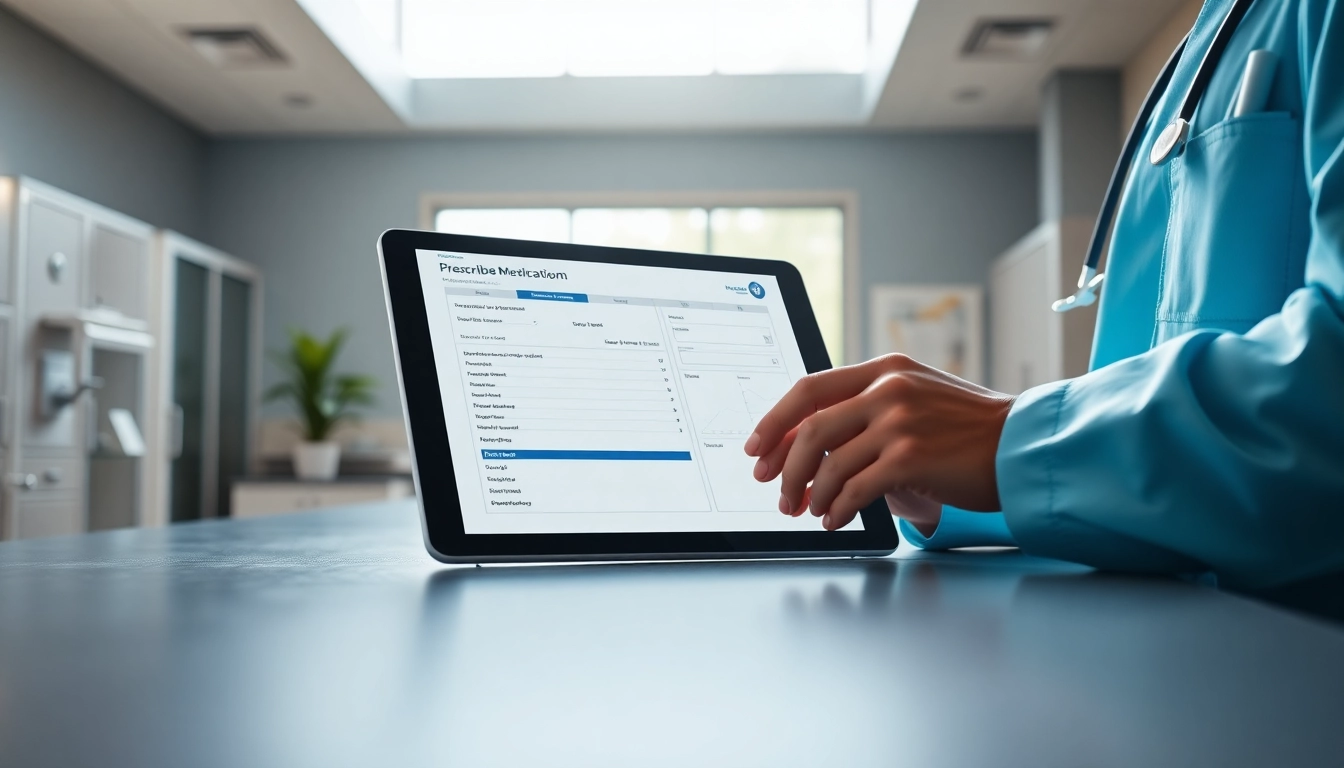
Understanding Eprescribing Software for Doctors
In an era where healthcare is rapidly evolving, the adoption of technology has become a cornerstone of patient care. One of the breakthrough advancements in medical technology is the introduction of ePrescribing software for doctors. This transformative tool not only enhances the prescription process but also significantly improves patient safety and data management. Implementing ePrescribing systems can streamline operations, alleviate burdens on healthcare providers, and foster better pharmacist-patient relationships.
Eprescribing software enables healthcare professionals to send prescriptions electronically to pharmacies, thus eliminating the need for paper prescriptions. The reliance on technology in medication management is growing, making understanding and leveraging these solutions critical for modern practices. As healthcare systems seek to optimize compilation, accuracy, and patient care, exploring the functionalities and advantages of ePrescribing software becomes essential. For a deeper understanding, consider exploring eprescribing software for doctors, which integrates seamlessly into existing workflows.
What is Eprescribing?
Eprescribing, also known as electronic prescribing, entails the digital generation and transmission of prescription orders via a secure network. This process is designed to replace handwritten prescriptions, reducing the chances of errors and enhancing efficiency. When a doctor prescribes medication electronically, the information is sent directly to the patient’s pharmacy of choice. This approach not only minimizes the risk of misunderstandings but also allows for real-time updates regarding medication availability and potential patient alerts.
Key Benefits of Eprescribing Software for Doctors
The investment in ePrescribing software yields a multitude of benefits:
- Improved Accuracy: Eprescribing mitigates handwritten errors, ensuring that the right medication is dispensed to the right patient.
- Enhanced Workflow Efficiency: Automating the prescription process allows healthcare providers to focus more on patient care instead of paperwork.
- Cost Savings: Reduced paperwork and improved efficiency can lead to lower operational costs for practices.
- Better Access to Patient Medication History: With integrated systems, doctors can easily access patient medication histories, resulting in informed decisions.
- Patient Convenience: Patients benefit from fewer trips to the office and quicker access to their medications, enhancing their overall experience.
Compliance and Regulations
While implementing ePrescribing software can significantly enhance healthcare delivery, it is also essential to adhere to regulatory standards. In many countries, ePrescribing systems must comply with rules set forth by health administrators to ensure patient safety and data privacy. Familiarization with regulatory requirements allows clinics to avoid legal repercussions and harness the full benefits of this technology. Ensuring compliance with the latest standards, such as HIPAA in the United States, is crucial to safeguarding patient data and optimizing software use.
Core Features of Eprescribing Software for Doctors
User-Friendly Interfaces
One of the paramount characteristics of effective ePrescribing software is its user-friendly interface. The complexity of medical practices should not hinder a doctor from utilizing an ePrescribing system effectively. An intuitive design promotes quick navigation, enabling healthcare professionals to easily manage prescriptions and patient data with minimal training. The software should provide straightforward functionalities such as prescription search, history tracking, and secure electronic signatures.
Seamless Integration with EHR Systems
Integration capabilities are a vital component of ePrescribing software. Many healthcare providers operate various electronic health record (EHR) systems, and the ePrescribing tool must integrate seamlessly with these platforms. This interoperability allows for fluid data exchange, ensuring that prescriptions are updated in real time within patient records. A well-integrated system negates the need for redundant data entry and provides holistic insights into patient care.
Medication Error Reduction
Utilization of ePrescribing software translates directly into a marked reduction of medication errors. Such systems offer features like drug interaction checks and allergy warnings, providing physicians with crucial information before finalizing a prescription. Additionally, automated refill reminders can prevent lapses in medication adherence, proving beneficial for chronic illness management where continuous treatment is necessary.
Implementing Eprescribing Software for Doctors
Steps for Successful Adoption
The adoption of ePrescribing software should follow a structured approach to ensure successful implementation:
- Assessment of Needs: Evaluate the practice’s specific requirements to identify the most suitable software that aligns with operational objectives.
- Vendor Selection: Research potential software providers to find a solution known for reliability, support, and compliance with regulatory standards.
- Implementation Planning: Develop a timeline and logistical plan for integrating the software, detailing hardware upgrades if necessary.
- %Staff Training: Ensure that all clinical and administrative staff receive appropriate training on the new system to foster familiarity.
- Launch and Monitor: After launching the software, continuously monitor usage patterns and gather feedback to identify areas for improvement.
Training and Support Solutions
Proper training is vital in guaranteeing user competency and confidence in the new ePrescribing system. Providers should offer comprehensive training sessions covering both basic functions and advanced features. Continuous support, including access to technical help desks, can greatly assist users in overcoming initial challenges. Engagement with regular refresher training sessions will help to maintain proficiency and keep staff updated about evolving software functionalities.
Common Challenges and Solutions
Despite the numerous advantages of ePrescribing, challenges can arise during its implementation. Common issues include resistance to change among staff, technical difficulties, and integration woes with existing systems. Strategies to tackle these include offering change-management workshops, ensuring strong IT support throughout the transition period, and practicing open communication with staff regarding the goals and benefits of switching to ePrescribing.
Best Practices for Using Eprescribing Software for Doctors
Ensuring Patient Data Security
To safeguard patient data while utilizing ePrescribing software, practices should implement rigorous security protocols. This may include encrypting sensitive information and educating staff on best practices regarding passwords and data handling. Regular audits of the software and security updates are also recommended to ensure that systems remain protected against breaches.
Maximizing Prescription Accuracy
Maximizing prescription accuracy can be achieved through several measures: always cross-refer to patient records, utilize drug interaction alerts effectively, and encourage patient engagement through consultations about their medications. Engaging patients in discussions about their treatment plans can also help verify that prescriptions align with their health needs and alleviate potential issues.
Enhancing Communication with Pharmacies
Effective communication between physicians and pharmacies can be improved through the functionalities available in ePrescribing software. Features including direct messaging capabilities allow for real-time dialogue regarding prescriptions and facilitate swift resolutions to any issues. Building solid relationships with local pharmacies ensures a smoother supply chain and can foster better patient follow-ups.
Measuring Success with Eprescribing Software for Doctors
Key Performance Indicators
To evaluate the success of ePrescribing software implementation, practices should define specific Key Performance Indicators (KPIs). Metrics may include:
- Reduction in prescription errors
- Increased prescription fulfillment rates
- Time savings for physicians and administration
- Improvement in patient compliance with treatment regimens
Gathering User Feedback
Regular feedback collection from staff and patients is necessary for an ongoing assessment of the ePrescribing tool. Methods such as surveys, one-on-one interviews, and focus groups can provide insights into software usability and pinpoint areas for enhancement. Taking actionable steps based on feedback can reinforce employee satisfaction and overall software effectiveness.
Continuous Improvement Strategies
Improvement strategies should involve ongoing education of healthcare providers on new features and updates within the software. Staying attuned to advancements in medication management technology can be critical to ensuring that practices remain competitive. Regular audits and performance reviews will help refine approaches to ePrescribing, bolstering clinic operations and elevating patient care.







